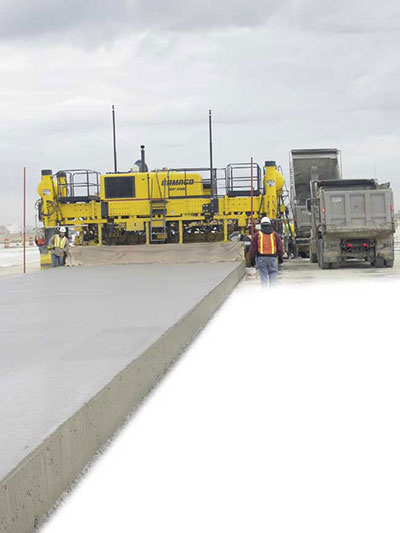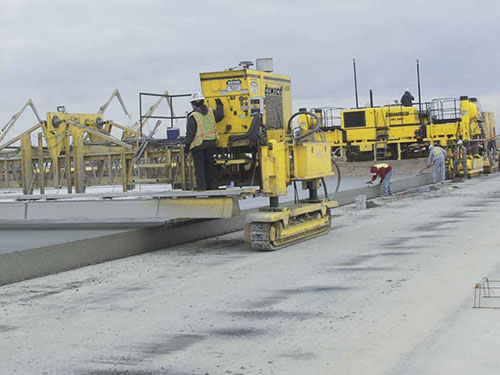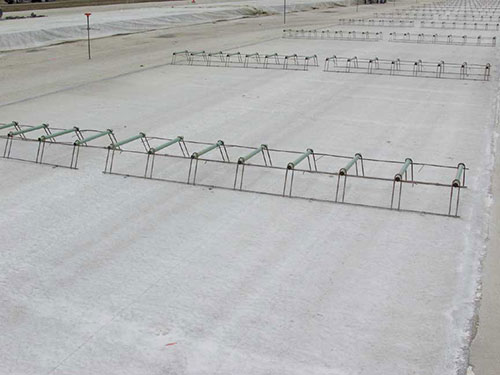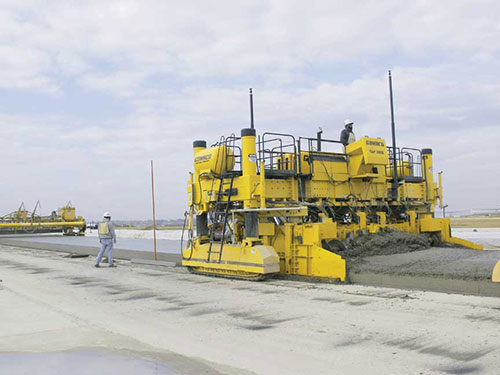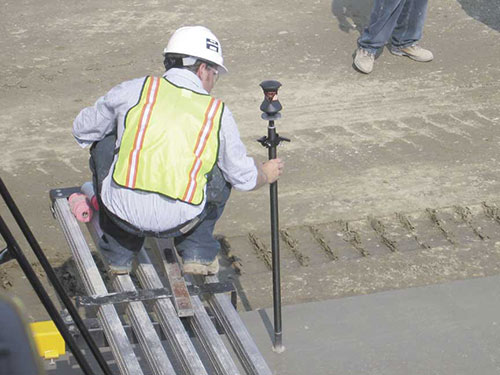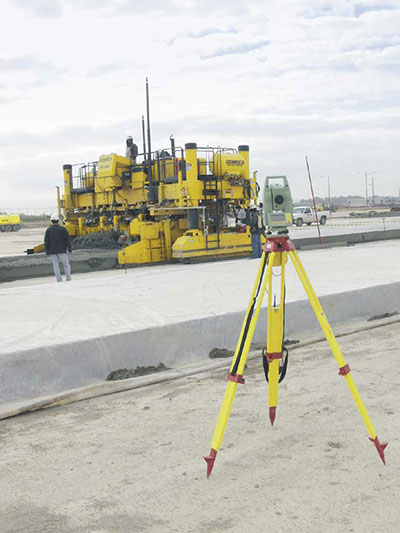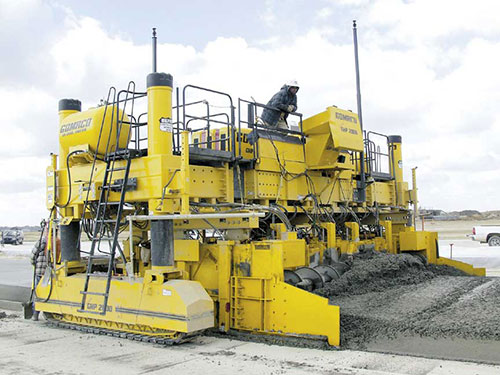GOMACO World Index --- GOMACO World 34.1 - February 2006
If You Don’t Change With The Times, You’re Left Behind...
Berns Construction Company has been in the concrete paving business since 1928. The family-owned concrete company specializes in highway and airport work. The majority of their work has been on the interstate transportation system and, during the last 15 years, the rehabilitation of that system.
The progressive-thinking company has never shied away from new technology. They’ve been following the progress of stringless technology and have even implemented a GPS system on their bulldozers and motor graders. The next step was a stringless system for their concrete paving work.
Berns Construction knew they had a large project coming up at the Indianapolis International Airport in Indianapolis, Indiana. They did some research into GOMACO pavers equipped with the Leica 3D stringless guidance system.
“I really think this stringless system in concrete paving is the wave of the future,” Dan Keys, president of Berns Construction, said. “That was our reason for getting involved, particularly here at the Indianapolis Airport. We thought it lent itself to a good application to the apron paving that we’re doing here.”
The project is a complete new terminal and apron at the airport. It’s a one billion dollar project that includes a new apron to connect to existing runways. It also includes entrance roads into the airport. All total, they’ll be slipforming 500,000 square yards (418,064 m2) of 16 inch (406 mm) thick apron paving, as well as 100,000 square yards (83,613 m2) of roadways coming into the new terminal.
Berns had the choice of putting down one of three subbases on the project: cement-stabilized base, asphalt or econocrete. Berns Construction, being concrete pavers and having all the necessary equipment, chose the econocrete option. It would also be a chance for the company to learn the 3D stringless system before starting the apron paving.
“The econocrete is a lean mix design of concrete,” Tim Hartgrove, project manager for Berns Construction, said. “There’s minimum and maximum specifications on it, for example, it can’t be over 1200 psi (8.3 MPa).”
All of the econocrete on the project is paved with the GHP-2800 and is six inches (152 mm) thick. D1 dowel baskets are placed on the grade 20 feet (6.1 m) apart to form the transverse joint. Project designers were concerned about the concrete sticking to the econocrete, so eight hours before a lane is paved, Berns uses their GOMACO T/C-600 texture/cure machine to spray the econocrete and baskets with a wax-based curing compound.
With the econocrete subbase down, baskets in place and the bond-breaker sprayed, concrete paving can begin. Hartgrove and his crew head out an hour before paving is scheduled to begin to set up the 3D system.
“We show up and get our three total stations set up. We use three because two are always on the paver guiding it, and the third we use to leap frog ahead and for as-built checks behind the paver,” Hartgrove explained. “There are a total of five different prisms that come with the system and two of those are on the paver. The other three prisms are set up on reference points located on the project.
“We hook the Leica computer up to the GOMACO G21 controller and turn it on. Then you go back to the total stations and sight them in so they’re ready to go. You go back to your Leica computer, pick the reference line for the day that you’re going to pave off. It’s just like stringline. You pick the line and you give it an offset. For instance, we’re paving 20 feet (6.1 m) wide so we offset 10 feet (3 m) to the center of the machine. That’s all you do. It’s just like you have invisible stringline out there.”
The project is being slipformed in 20 foot (6.1 m) wide lanes that are 16 inches (406 mm) thick. They slipform a pilot lane, skip a lane and then do another pilot lane, eventually going back and filling in all of the gaps. All of the joints on the apron, both longitudinal and transverse, are 20 feet (6.1 m) apart.
“Edge slump on the apron is very important and we’re pouring the concrete pretty dry,” Keys said. “The GHP-2800 two-track is doing a great job and the edge takes very little attention.”
The concrete mix design was modified to accommodate the cooler temperatures in Indianapolis at the time. They’re running 100 percent cement in the mix and eliminated the fly ash. Slump averages one inch (25 mm).
The T/C-600 follows behind the paver applying a burlap-drag finish. The new concrete also has to be covered with plastic when the temperatures approach the freezing point.
GOMACO had the opportunity to visit Berns’ job site, in person, just four weeks into their stringless paving venture. Their reactions to the new system were interesting and it was surprising to hear them describe the new system as “boring.”
“When you undertake any new process, you’re going to be apprehensive and we were worried if we were going to be able to grasp the idea,” Hartgrove explained. “The 3D system turned out to be simpler than what we thought. It can’t be too complicated. Basically, you’ve got northings, eastings and elevations. Everything is controlled by those points. You’re simply moving from one point to another point on each side of the paver.”
The biggest fear for a contractor making the move to the stringless 3D system has to be the fear of paving in the wrong place or out of tolerance. Without stringline, there’s no visual confirmation. The 3D system has checks and safeguards built into the system to make sure that doesn’t happen.
“The first time with the system was scary,” Hartgrove said. “We were out there in the middle of nowhere and trying to pick our reference line for the day. We had some idea where the pavement was going, so we pulled our paver up, picked our reference line and the computer with the Leica system on the paver said, ‘You’re off two hundred feet (61 m) pal. You’re on the wrong reference line.’ And you have the chance to adjust the paver and get it in position before any concrete is on site.”
The third total station on the project plays a crucial part in monitoring accuracy also. Berns uses a sixth prism, a mini-prism, that they can sit right on the concrete coming out the back of the paver. The third total station takes shots at that prism and then relays the information to the Leica computer. The computer instantly displays that information and stores it for future reference. All of it can be downloaded off the computer and used for reports.
“You can program the computer to tell you whatever information you want about the project,” Hartgrove said. “At the end of the day, I can download that information and take it with me. That data tells your tolerances, your as-built checks, where the total stations were setup, your elevations, what the design was, how much we paved that day and whatever else you’ve programmed into the computer.”
All of this information can be viewed on the Leica computer during paving as well. If a question arises, the computer is designed to be able to toggle through different screens of information and not disrupt the paving process.
“There’s a series of computer screens that you can toggle through and you can learn anything you want to about what’s going on with the paver,” Hartgrove said. “You can see where the paver is, the front and the rear of the paver in relationship to the actual design, cross slope, feet per minute, stationing, how far away you are from the total stations and all those things. The guys can come around there and look and see what exactly is happening with the paver at any time.”
The 3D system is also more accurate than the traditional stringline method. It eliminates the human error involved with the setting of stringline and issues that can happen during the paving process with the stringline getting bumped or even cut.
“This system is definitely more accurate than stringline,” Hartgrove said. “What we’ve always done with stringline is have a survey crew go out, put a hub with a tack in it for line and elevations every 25 feet (7.6 m). Another crew drives the pins for the stringline and measures up from the tack. When you’re on a road job, you have two stringlines, with a high and a low stringline that controls each edge of the paver. Then the day of paving, you have a crew that goes along and eyeballs the stringline tapping the stake down a little bit or raising it up. All that room for human error is eliminated with the 3D system.
“Plus, you don’t have to worry about stringline, people messing with your stringline, buying the stringline, or messing with all of the parts that go along with stringline.”
The system has been designed to be understandable and user-friendly in every way. As Hartgrove likes to point out, you don’t have to be a rocket scientist to understand it.
“I was probably one of those people who said that I’d never pull a concrete paver up to an open area without stringline and just start paving,” he said. “When you first look at something like this, you’re going to say you have to be a rocket scientist to be able to figure this thing out. Actually, the system can’t be too much simpler than what it is. It’s just a series of points and you’re going from one point to another, just like you’d put up stringline.
“We’ve been doing it for four weeks now, and to tell you the truth, it’s kind of boring.”
Berns Construction recently won another contract at the Indianapolis Airport to slipform a new north apron that they’ll start on in the spring. A majority of their time through 2007 will be spent working on the airport. They also have plans of taking their stringless system out on interstate paving projects.
“Our people have adjusted very well, adapted to the Leica system and have found it user friendly,” Keys said. “We’ve taken the opportunity here to get involved with the stringless system. I believe that if you don’t change with the times, you’re left behind.”
It’s obviously a successful philosophy for Berns Construction. They’ll celebrate their 78th anniversary in the concrete paving business this year.
Subscribe to Receive GOMACO World Magazine
